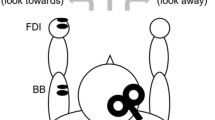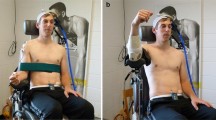Abstract
We examined whether the recruitment properties of the corticospinal pathway to intrinsic hand muscles are influenced by variations of the shoulder joint angle. Abductor digiti minimi (ADM) motor evoked potentials (MEPs) in response to transcranial magnetic stimulation were examined during different static positions of the shoulder joint in the horizontal plane from 30° adduction to 30° abduction with respect to the neutral position at 0°, while elbow and wrist joints were constrained statically at 90° and 180° respectively. We found that 30° abduction of the shoulder significantly depressed MEP size and prolonged MEP latency in comparison with 30° shoulder adduction. The neutral shoulder angle position (at 0°) significantly reduced MEP size but had no effect on MEP latency in comparison with 30° shoulder abduction. The input–output relationship between MEP size and stimulus intensity was sigmoidal. The plateau value and maximum slope were significantly lower at 30° abduction than at 30° adduction of the shoulder. However, the threshold value did not differ significantly between the two positions. To differentiate excitability changes at cortical versus subcortical sites, intracortical inihibition (ICI) and intracortical facilitation (ICF) were assessed using a paired-magnetic pulse paradigm. A significant decrease in ICF was observed after changing shoulder position from 30° adduction to 30° abduction. In contrast, no variation in the amount of ICI occurred in relation to the same changes in shoulder position. ADM F-waves elicited by electrical stimulation of the ulnar nerve at the wrist were significantly decreased at 30° shoulder abduction in comparison with 30° adduction. A similar pattern was observed in one subject in whom the H-reflex could be exceptionally elicited in ADM. We conclude that shoulder position influences the recruitment efficiency (gain) of the corticospinal volleys to motoneurons of intrinsic hand muscles. It is proposed that activity of peripheral receptors signalling static shoulder position influences corticomotor excitability of hand muscles both at the cortical and at the spinal level. This modulation may be functionally relevant when reaching to grasp objects.






Similar content being viewed by others
References
Capaday C (1997) Neurophysiological methods for studies of the motor system in freely moving human subjects. J Neurosci Methods 74:201–218
Capaday C, Lavoie BA, Barbeau H, Schneider C, Bonnard M (1999) Studies of the corticospinal control of human walking. I. Responses to focal transcranial magnetic stimulation of the motor cortex. J Neurophysiol 81:129–139
CarrollTJ, Riek S, Carson RG (2001) Reliability of the input–output properties of the cortico-spinal pathway obtained from transcranial magnetic and electrical stimulation. J Neurosci Methods 112:193–202
Chapman CE, Sullivan SJ, Pompura J, Arsenault AB (1991) Changes in hip position modulate soleus H-reflex excitability in man. Electromyogr Clin Neurophysiol 31:131–143
Chen R, Tam A, Butefisch C, Corwell B, Ziemann U, Rothwell JC, Cohen LG (1998) Intracortical inhibition and facilitation in different representations of the human motor cortex. J Neurophysiol 80:2870–2881
Day BL, Dressler D, Maertens de Noordhout A, Marsden AC, Nakashima K, Rothwell JC, Thompson PD (1989) Electric and magnetic stimulation of human motor cortex: surface EMG and single motor unit responses. J Physiol 412:449–473
Devanne H, Lavoie BA, Capaday C (1997) Input–output properties and gain changes in the human corticospinal pathway. Exp Brain Res 114:329–338
Devanne H, Cohen LG, Devanne Kouchtir N, Capaday C (2002) Integrated motor cortical control of task-related muscle during pointing in humans. J Neurophysiol 87:3006–3017
Jeannerod M, Arbib MA, Rizzolatti G, Sakata H (1995) Grasping objects: the cortical mechanisms of visuomotor transformation. TINS 18:314–320
Jones EG (1987) Ascending inputs to, and internal organization of, cortical motor areas. In: Bock G, O’Connor M, Marsh J (eds) Motor areas of the cerebral cortex. John Wiley, Chichester, pp 21–39
Kaelin-Lang A, Cohen LG (2000) Enhancing the quality of studies using transcranial magnetic and electrical stimulation with a new computer-controlled system. J Neurosci Methods 102:81–89
Kaelin-Lang A, Luft AR, Sawaki L, Burstein AH, Sohn YH, Cohen LG (2002) Modulation of human corticomotor excitability by somatosensory input. J Physiol 540:623–633
Kalaska JF, Drew T (1993) Motor cortex and visuomotor behavior. Exerc Sport Sci Rev 21:397–436
Kalaska JF, Scott SH, Cisek P, Sergio LE (1997) Cortical control of reaching movements. Curr Opin Neurobiol 7:849–859
Knikou M, Rymer WZ (2002a) Hip angle induced modulation of H reflex amplitude, latency and duration in spinal cord injured humans. Clin Neurophysiol 113:1698–1708
Knikou M, Rymer Z (2002b) Effects of changes in hip joint angle on H-reflex excitability in humans. Exp Brain Res 143:149–159
Kujirai T, Caramia MD, Rothwell JC, et al. (1993) Corticocortical inhibition in human motor cortex. J Physiol 471:501–519
Liepert J, Schwenkreis P, Tegenthoff M, Malin JP (1997) The glutamate antagonist riluzole suppresses intracortical facilitation. J Neural Transm 104:1207–1214
Mamassian P (1997) Prehension of objects oriented in three-dimensional space. Exp Brain Res 114:235–245
Mazzocchio R, Rossi A (1997) A method for potentiating Renshaw cell activity in humans. Brain Res Protoc 2:53–58
Mazzocchio R, Rothwell JC, Day BL, Thompson PD (1994) Effect of tonic voluntary activity on the excitability of human motor cortex. J Physiol 474:261–267
Mazzocchio R, Rothwell JC, Rossi A (1995) Distribution of Ia effects onto human hand muscle motoneurones as revealed using an H reflex technique. J Physiol 489:263–273
Nielsen J, Petersen N (1994) Is presynaptic inhibition distributed to corticospinal fibres in man? J Physiol 434:47–58
Orth M, Snijders AH, Rothwell JC (2003) The variability of intracortical inhibition and facilitation. Clin Neurophysiol 114:2362–2369
Palmer E, Ashby P (1992) Corticospinal projections to upper limb motoneurons in humans. J Physiol 448:397–412
Park MC, Belhaj-Saif A, Gordon M, Cheney PD (2001) Consistent features in the forelimb representation of primary motor cortex in rhesus macaques. J Neurosci 21:2784–2792
Ridding MC, Taylor JL, Rothwell JC (1995) The effect of voluntary contraction on cortico-cortical inhibition in human motor cortex. J Physiol 487:541–548
Robinson KL, McComas AJ, Belanger AY (1982) Control of soleus motoneuron excitability during muscle stretch in man. J Neurol Neurosurg Psychiatry 45:699–704
Rossini PM, Barker AT, Berardelli A, et al. (1994) Non-invasive electrical and magnetic stimulation of the brain, spinal cord and roots: basic principles and procedures for routine clinical application. Report of an IFCN committee. Electroencephalogr Clin Neurophysiol 91: 79–92
Rothwell JC (1997) Techniques and mechanisms of action of transcranial stimulation of the human motor cortex. J Neurosci Methods 74:113–122
Rothwell JC, Thompson PD, Day BL, Boyd S, Marsden CD (1991) Stimulation of the human motor cortex through the scalp. Exp Physiol 76:159–200
Schafer M, Biesecker JC, Schulze-Bonhage A, Ferbert A (1997) Transcranial magnetic double stimulation: influence of the intensity of the conditioning stimulus. Electroencephalogr Clin Neurophysiol 105:462–469
Schulze-Bonhage A, Knott H, Ferbert A (1996) Effects of carbamazepine on cortical excitatory and inhibitory phenomena: a study with paired transcranial magnetic stimulation. Electroencephalogr Clin Neurophysiol 99:267–273
Scott SH (2000) Role of motor cortex in coordinating multi-joint movements: is it time for a new paradigm? Can J Physiol Pharmacol 78:923–933
Thompson PD, Day PL, Rothwell JC, Dressler D, Maertens de Noordhout A, Marsden CD (1991) Further observations on the facilitation of muscle responses to cortical stimulation by voluntary contraction. Electroencephalogr Clin Neurophysiol 81:397–402
Tokimura H, Di Lazzaro V, Tokimura Y, et al. (2000) Short latency inhibition of human hand motor cortex by somatosensory input from the hand. J Physiol 523:503–513
Ziemann U, Lonnecker S, Steinhoff BJ, Paulus W (1996a) The effect of lorazepam on the motor cortical excitability in man. Exp Brain Res 109:127–135
Ziemann U, Rothwell JC, Ridding MC (1996b) Interaction between intracortical inhibition and facilitation in human motor cortex. J Physiol 496:873–881
Ziemann U, Tergau F, Wassermann EM, Wischer S, Hildebrandt J, Paulus W (1998) Demonstration of facilitatory I wave interaction in the human motor cortex by paired transcranial magnetic stimulation. J Physiol 511:181–190
Acknowledgements
This study was funded in part by a University of Siena Research Grant (PAR 2003). We thank R. della Volpe, P. Milani, R. Spidalieri and T. Popa for their assistance during some of the experiments.
Author information
Authors and Affiliations
Corresponding author
Rights and permissions
About this article
Cite this article
Ginanneschi, F., Del Santo, F., Dominici, F. et al. Changes in corticomotor excitability of hand muscles in relation to static shoulder positions. Exp Brain Res 161, 374–382 (2005). https://doi.org/10.1007/s00221-004-2084-x
Received:
Accepted:
Published:
Issue Date:
DOI: https://doi.org/10.1007/s00221-004-2084-x




